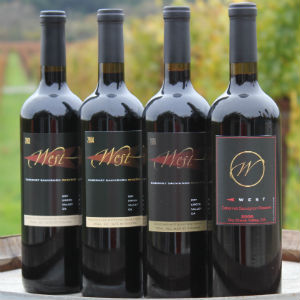How to do a Vertical Tasting

How to do a Vertical Tasting
Monday November 14, 2016
Gather your Friends for a Fun Vertical Tasting
One of the more fun wine tastings to do is a vertical tasting. It means that you use the same wine, i.e. the same varietal from the same vineyard from a number of different years. Invite a group of friends who like wine, they do not have to be experts, neither do you. You are actually about to learn a lot from tasting the same wine from different years and you can do it just for fun and notice the differences and enjoy the wines, or you can go about it more seriously and take notes, discuss and compare.
Which wines to choose?
If you can find them, bottles from consecutive years are very interesting but it can also be years more spread out in time. You need to use a wine that has aging potential and which develops new interesting flavors as it matures. One of the best wines to use is Cabernet Sauvignon or blends with Cabernet Sauvignon such as Bordeaux wines. Use 3-5 wines from the same winery, the same vineyard, and preferably the same winemaking style, what is called vineyard designated wines. The point is to learn about the differences and similarities that come from the aging in barrel and bottle as well as the impact of different weather in different years. Some wineries make the same wine every year but get the grapes from different places and focus on creating exactly the same flavors. That means that you are not comparing the same grapes or growing conditions. So they would not be as suitable for a vertical tasting. You are most likely to find vineyard designated wines from smaller wineries with their own vineyards or, if a bigger winery, specific wines made from the same vineyard every year.
At West Wines we make Cabernet Sauvignon from our estate grapes from the very same west-facing slope every year so they are indeed vineyard designated. I also use the same winemaking procedures ensuring that the differences are attributed to variances of weather patterns and the aging time. You will be surprised how much difference a year makes. We hold back a small percentage from every vintage for the purpose of enjoying the wines as they age and some are available for our clients as well.

How to arrange a tasting
You can do this in a very small group or get a larger group together. For a tasting you only have to pour about 2 ounces of each wine so you can use a bottle each of four wines for up to 12 people. You would have enough to pour 2 ounces per person and still have a glass per person left of each wine if you are a group of four. That means you can continue to enjoy each ones favorite with dinner. Or you can be a bigger group of 12 people and let each one get a 2 ounce tasting of each wine. A regular glass of wine is about 4-5 oz.
You do not have to be formal. The purpose can simply be just to experience the differences and similarities of the wines, enjoy the flavors, take some notes, or not, and talk about what everyone thinks about the wine. And then get on with some good food.
You can also structure the tasting so that each wine is sampled one at a time while everyone takes notes about what they perceive. Then you can discuss each wine briefly while tasting it and when they are all tasted you compare notes on differences, similarities and favorites. You do not need to be wine experts. This is about what you actually experience. Some guests who are more knowledgeable and some who are not is a fine mix actually. For each wine I like to note the color, the clarity, the bouquet, the taste. There are no right or wrong words but you can read some of the flavors that I am reminded of when tasting in this blog post about aging wine and you should continue to create your own as well.
When you taste you first look at the wine in the glass and note the color, is it bluish red, dark red, brick red? Is it clear? Does the wine have sediments in the bottom? You may have to look at the bottle as sediments are typically left in the bottle. Remember that sediments only shows that the wine was not heavily filtered and are actually a good sign since more flavors are left in the wine.
Next you start smelling the wine. What do you think it smells like? Anything it reminds you of?
When it comes to tasting you can take a small sip and swirl it in your mouth. What does it taste like? How does it taste on the tip of your tongue and how does it taste at the back of your mouth? How does it taste when you take the second sip? Some flavors come forward after the wine has been in the glass a little while, after you swirl the glass. The reason is that flighty compounds that are what you first perceive have taken of and left others to come to the forefront.
Some people will want to spit so it is good to have a cup available for them. However, unless you are tasting a huge amount of wines, I do not think it is necessary for a fun evening tasting wine with friends. Here is a simple form to use to note your findings as you taste.
You will want to have information about the wine handy. Either you let everyone read and learn about the wine you have picked when you start the tasting, or you do the tasting and then have information available of what you just tasted. For our Cabernet Sauvignon we have information of every vintage available online to download.
In what order should we taste?
When tasting wines we are most often taught to go from white wines to red wines, from softer to bolder wines and from drier to sweeter. When tasting a vertical series of wines we usually divert from this since we advise to start with the youngest wine and work backwards in time. The younger wines tend to be more fruity but also more tannic and astringent but with each year the flavors get more complex but also rounder. In a vertical tasting you are also looking to see what happens to that specific wine as it ages and what different years have in store. Therefore I suggest you start with the youngest and think about how the wine ages for each wine you try. You will be traveling in time!
You will also find that it is fun to revisit the same vertical wines a year later and see what has happened with another year in the bottle. So you can make the vertical tasting to an annual event.
Food
During your tasting you will not want to have too much food to start with. The purpose is to explore the wines, so crackers or white bread and water are the best companions. But when you are done with your smaller amounts of samples you can add anything from cheeses and charcuteries to a full meal and continue to enjoy your vertical flight. Or you may move on to another wine. Red wines have tannins which marry specifically well with protein which is why we often pair them with cheese or meat. The proteins bind with tannins and create a supple round mouthfeel. A vegetable dish with a creamy sauce can also do the trick. Check out some of our recipes.


